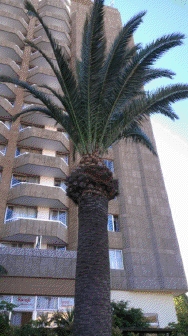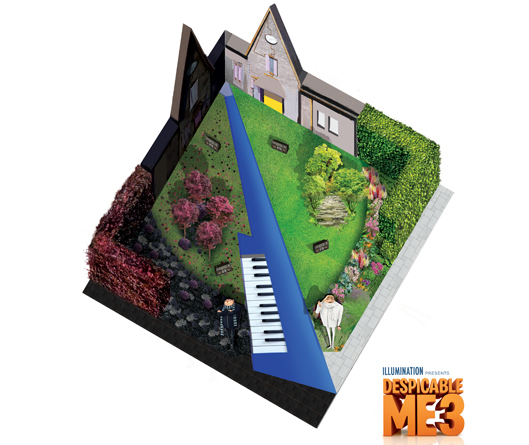When I go on a holiday to the sun (the big yellow thing in the sky, reputed to appear in Ireland from time to time) I am always fascinated by the palm trees. This winter we escaped the rain for a week in Tenerife, and for the sake of my wife I tried not to make it too much of a busman’s holiday.
There appears to be two common types of palms: Phoenix with the pinnate fronds, and Washintonia with the palmate (palm like) fronds. There is then a bewildering array of much less common ones.
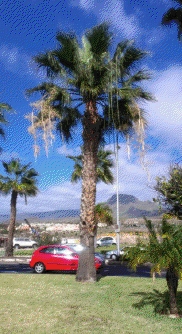
Washintonia filifera with streamers
Phoenix canariensis, the canary island palm appears to be the most planted. When young it has that very characteristic bulge in the trunk, reminiscent of a pineapple. It can be confused with the very similar date palm, Phoenix dactylifera, which usually has a thinner trunk and foliage that is a bit greyer and not as full. It looks almost unhealthy against the canary palm.
Washintonia filifera with the palmate fronds is generally the tallest palm around. It has a good thick trunk, smoother than Phoenix. It has very characteristic hanging streamers. Washintonia robusta is also common, it has a thinner trunk, that you could say is less robust
Just as interesting is the way these palms are looked after. Every year or so all the old and tatty fronds are cut out. This would have been a difficult and dangerous job in the old days (some of these palms have well hidden, vicious spines as well) but now with cherry pickers and chain saws the job is much easier. It might seem a lot of work, in comparison to ‘normal’ trees, but once the fronds are cut off and removed, that’s the end of it. If you compare that with Eucalyptus trees, which are all year round littering machines, particularly noticeable in dry climates.

Phoenix canariensis recently pruned
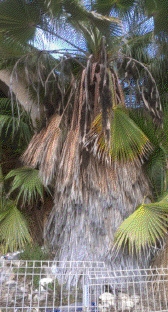
A sad looking and neglected Washintonia
The leaf stalks are not completely removed, the cut ends attached to the trunk are left behind and eventually fall off in their own time. These are what give the Canary palm trunk its characteristic pineapple look. If old fronds are not removed palm trees look absolutely terrible, see photo above.
This is the way we should have dealt with the large Cordylines when we had them, rather than let the old leaves fall off and go everywhere. They had a great knack of wrapping around the lawn mower blades.
In Ireland we grow two palms with reasonable success. Both have palmate leaves. The windmill palm, Trachycarpus fortunei, is the best known, and generally came through in the last hard winter. You do occasionally see good specimens, but in general they look miserable. The secret is to get
good sized (and expensive) plants to start with. It’s just a waste of time putting in something small. There appears to be a lot of variants of this plant.
The other palm, which is actually a European native, is Chamaerops humilis, unlike Trachycarpus it rarely forms a trunk. It did surprisingly bad in the last hard winter. There are definitely lots of different variants of this plant, some with nice silvery leaves, and no doubt different degrees of hardiness.
Beware the canary island palm (and not just for its vicious hidden thorns) which makes its appearance on sales benches every summer. It makes a good and relatively cheap (for a palm) centre piece for a pot, or as a spot plant in a summer bedding display, but that’s about it. It is not suitable as a long term garden plant in this country, though often sold as such. It will come through a mild winter but will never make progress in our cool summers. So over time it will just fade away. It is just not fair for landscapers to use large specimens of this plant to make instant gardens, for the client, or the plant.
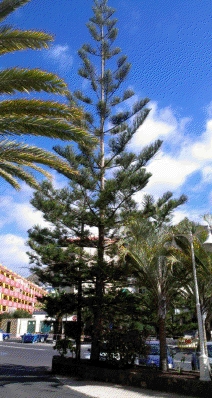
Araucaria heterophylla – Norfolk Island Pine happy in Tenerife
I saw a well known tele gardener cutting off the dead fronds of a canary palm, and assuring the viewers that it would re-grow – perhaps it would if it was a thousand miles further south!
PS There is one other very iconic plant occasionally seen on the skyline in the sunny south. It looks almost too perfect and symmetrical to be real. It is the Norfolk Island pine, and not hardy, alas, in this country. It looks so amazing, with all the well spaced branches radiating out from a flagpole like trunk. When old it gets congested and loses some of its looks, like us all!
In Ireland we grow its relation, which is also a very symmetrical and iconic tree particularly when semi mature and growing strongly. This is the monkey puzzle tree, Araucaria araucana, with its formidable spiny leaves. These evolved a long time age to deter dinosaurs from eating it and well before the health and safety man came on the scene.
Monkey puzzles are slow starters and expensive for decent sized ones, but once they settle in and get over the metre in height they really start to move! I wish they’d come back into fashion.

“John has a diploma in Horticulture from the National Botanic Gardens, a degree in Botany from Trinity College and a diploma in Tree Craftsmanship from Merrist Wood College in Surrey. He worked in the nurseries of north Germany where he got his interest in craft gardening. He is the owner of Ratoath Garden Centre, whose slogan “mad about plants”, is not far from the truth!”
Source: HortiTrends News Room


